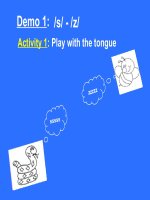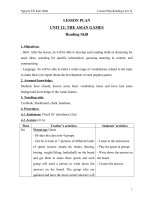Unit 12. Language focus-English 11
Bạn đang xem bản rút gọn của tài liệu. Xem và tải ngay bản đầy đủ của tài liệu tại đây (114.55 KB, 6 trang )
Lesson plan
Unit 12: The Asian games
Lesson: 5 Part E: Language focus
Coach: Nguyen Thi Thu
Trainee: Tran Thi Lan
Class: 11A6
Date of preparing 04/03/2010
Date of teaching: 06/03/2010
I. Objectives
By the end of the lesson, students will be able to:
- Distinguish the clusters /str/, /skr/, /skw/.
- Pronounce the words and dialogue containing these clusters correctly.
- Master the use of relative clauses and equivalent types of clauses without relative
pronouns.
- Use these structures correctly and appropriately to solve communicative tasks.
II. Materials: handouts, blackboard, textbook.
III. Anticipated problems:
Students may not have difficulty in pronouncing the clusters because they do not
exist in Vietnamese. Therefore, teacher should guide them to pronounce correctly.
IV. Procedures
Time Teacher’s activities Students’ activities
Warm-
up
5(mins)
- T greets the class:
+ Nice to meet you and How are you today?
+ Who’s absent today?
+ What have you learned in previous lesson?
-T: How do you pronounce these words?
+ Strength
+ Scratch
+ Squeal
- T: You will see these words in our lesson. And now, we
start our lesson today:
Unit 12: The Asian games
Lesson 5 Part E: Language focus
- Greet teacher and answer the
questions.
- Answer the teacher’s questions,
- Listen to the teacher and write
the title of the lesson on their
notebook.
1
Pronunc
iation
(10
mins)
- T: introduces some clusters such as /str/, /skr/, /skw/.
- T: guides Sts to produce these clusters: when
producing /str/, you should produce /s/ first and then
quickly switch to /tr/.
+ For example: street, strong, stream, stress…
+ The way of producing /skr/, /skw/ is the same.
- T: asks Sts to practice speaking these clusters.
- T: introduces some words which begin with these
clusters:
/str/ /skr/ /skw/
Street Scream Square
Strong Screen Squeeze
Strange Screw Squeak
Strength Scratch Squeal
- T: reads first then asks Sts to listen and repeat.
- T: asks Sts to listen to the teacher then to work in pairs
and take turn aloud the sentences on page 144.
Practicing reading aloud these sentences.
1. There was a strong man on the street at night.
2. The strong man looked very strange.
3. He was holding an ice-cream in one hand, and a rubber
doll in the other hand.
4. The man was eating the ice-cream, squeezing the doll
and it was squeaking.
5. The man was creaming while walking to the square.
6. Nobody knew why he was doing the strange things.
- T: goes around the class to see Sts practicing. Then T
calls some Sts to read again and gives them feedback.
- T asks Sts to practice speaking these clusters at home.
- Listen to the teacher.
- Practice speaking these clusters.
- Practice speaking /str/, /skr/,
/skw/.
- Listen and read after their
teacher
- Listen and repeat
- Work in pairs to practice
speaking
- Practice speaking these
sentences in 2 minutes
- Read the sentences again.
- Listen to their teacher’s
feedback.
2
Gramma
r (15
mins)
I. REVISION OF RELATIVE PRONOUNS
-T: you have learned about relative pronouns. Today, let’s
review them.
-T: shows some examples on the screen.
Example:
1. The woman who/ that is wearing T-shirt is Tom’s teacher.
2. The street which leads to my village is not very wide.
=>They are the subjects of the clauses.
- T: now, Work in pairs to find out “What is the role of
these relative pronouns?”
-T: you have 1 minute to find out the role.
- When time is up, T calls some Sts to talk about the role.
-T corrects the answers if necessary.
-T: you have reviewed about relative pronouns, now let’s
practice more.
Practice: Complete the sentences using relative
pronouns as a subject.
1. The woman is very friendly. She lives next door.
=> The woman who lives next door is very friendly
2. Mary is a nurse. She works in Thai Nguyen hospital.
=> Mary, who works in Thai Nguyen hospital, is a nurse.
3. My sister bought me a computer. The computer is very
useful.
=> My sister bought me a computer which is very useful.
- T asks each student to do each sentence.
- T: introduces other examples:
Example:
1. The man whom you saw yesterday is my uncle.
2. The book which you gave me is interesting.
- T: asks students to answer “What is the role of these
relative pronouns?”
=> They are the objects of the clauses
- T: asks Sts to practice more:
Practice: Complete the sentences using relative
- Listen to their teacher.
-Look at the screen.
- Answer their teacher’s question.
- Sts work in pairs to find out the
role of these relative pronouns.
-Listen to their teacher’s
requirement.
- Read through all the sentences
and try to find out the answers.
-Do each sentence.
- Think about the answer.
- Practice more about using
relative pronouns as an
object.
3
pronouns as an object.
1. Please post these letters. I wrote them this morning.
=> Please post these letters which I wrote this morning
2. The meeting was interesting. I went to it yesterday.
=> The meeting which I went to yesterday was interesting
3. Peter is an actor. You met him last night.
=>Peter, whom you met last night, is an actor.
4. John doesn’t want to sell the house. He lives in it.
=> John doesn’t want to sell the house which he lives in.
- T: asks Sts to answer “Can we omit relative pronoun in
this case?”
Example:
The meeting was interesting. I went to it yesterday.
The meeting which I went to yesterday was
interesting.
→ The meeting I went to yesterday was interesting.
The omission of relative pronouns.
Notice: We can leave out the pronoun when it is not the
subject of the relative clause. Clauses without pronouns are
very common in informal English.
Practice :Rewrite these sentences using Omission of
relative pronouns:
1. That man is a teacher. I talked to him yesterday.
=> That man I talked to yesterday is a teacher
2. Sa pa is the beautiful place. I was born in it.
=> Sa pa is the beautiful place I was born in
3. The girl is from Brazil. We are going to see her.
=> The girl we are going to see is from Brazil
4. This is the book. John gave it to me last week.
=> This is the book John gave to me last week
5. The bed was very modern. I slept in it last night.
=> The bed I slept in last night was very modern
- Try to think about their
teacher’s question.
-Listen to their teacher’s
explanation.
- Do other sentences
4
8 (mins)
5 (mins)
-T calls one student to read aloud the requirement of
exercise 1,2 and the sentences in the box.
Exercise 1: Complete each of the following
sentences, using a suitable sentence in the box to
make a relative clause without a relative
pronoun.
-
T: explains the requirement and then do example:
Example:
I like the diamond ring………………………
=> Mary is wearing
-T: analyze the example and asks Sts to work in pairs.
-T: you have 2 mins to do sentences 1, 2, 3.
-T goes around the class to observe the students to do.
-When time is up, T calls some Sts to go to the board to
write their answers.
-T checks Sts’ answers.
Keys:
1. you lost
2. he invited to the birthday party
3. John told
- T asks Sts to do other sentences at home.
-T: let’s move on exercice 3:
Exercise 3: Tick (ü) the sentences in which the
-Read the requirement of exercise
1.
-Listen to their teacher.
- Look through all sentences
- Work in pairs.
-Answer their teacher’ question.
- Read the requirement of
We had it for lunch we met him this
morning
John told them he invited them to
the birthday party
You lost it I bought it yesterday
5
relative pronoun can be omitted.
-T calls one student to read aloud the requirement of
Exercise 3.
- T explains new words if any.
- T asks Sts to work in pairs to discuss too exercise.
-T: you have 2 mins to do sentences 1, 2, 3.
-T goes around the class to observe the students to do.
-When time is up, T calls some Sts to go to the board to
write their answers.
-T checks Sts’ answers.
Keys:
1. Yes 3. Yes 5. Yes
2. No 4. Yes 6. Yes
exercise 3.
- Listen to their teacher.
- Work in pairs.
- Go to the board to write their
answers.
-Listen to their teacher’s answer.
Wrappin
g-up
(3 mins)
- T summarizes the main points:
+ Distinguish the clusters /str /, / skr /, and /skw /.
+ Pronounce the words and sentences containing these
clusters correctly.
+ Master the use of relative clauses and equivalent types of
clauses without relative pronouns.
+ Use these structures correctly and appropriately to solve
communicative tasks.
- T asks students to do homework:
+Do exercise 1, 2, and 3 again.
+Prepare for Reading of Unit 13.
- T says goodbye to the class.
-Repeat the main points
- Write the contents of
homework.
Coach’s comments:
Date: / /
Coach’s signature
6









